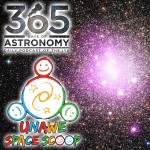Podcaster: Richard Drumm
 Title: Space Scoop: The Teeny Tiny Planet Destroyer
Title: Space Scoop: The Teeny Tiny Planet Destroyer
Organization: 365 Days Of Astronomy
Link : astrosphere.org ; http://unawe.org/kids/unawe1515/
Description: Space scoop, news for children.
Bio: Richard Drumm is President of the Charlottesville Astronomical Society and President of 3D – Drumm Digital Design, a video production company with clients such as Kodak, Xerox and GlaxoSmithKline Pharmaceuticals. He was an observer with the UVa Parallax Program at McCormick Observatory in 1981 & 1982. He has found that his greatest passion in life is public outreach astronomy and he pursues it at every opportunity.
Today’s sponsor: This episode of “365 Days of Astronomy” is sponsored by — no one. We still need sponsors for many days in 2015, so please consider sponsoring a day or two. Just click on the “Donate” button on the lower left side of this webpage, or contact us at signup@365daysofastronomy.org.
Transcript:
This is 365 Days of Astronomy. Today we bring you a new episode in our Space Scoop series. This show is produced in collaboration with Universe Awareness, a program that strives to inspire every child with our wonderful cosmos.
Today’s story is…
The Teeny Tiny Planet Destroyer
If you’re a fan of science fiction, you’ll have read about and seen some pretty crazy things, from time travel to the destruction of entire planets! We saw poor Spock’s home planet Vulcan destroyed in Star Trek, and in Star Wars Princess Leia’s home planet of Alderaan was blown to smithereens.
But does the destruction of planets really happen in the Universe, or is this just science fiction?
Astronomers have recently discovered evidence that a planet may have been destroyed in our very own Galaxy. Not only that, it appears to have been destroyed by a star that was once like our own Sun!
When a star like our Sun runs out of fuel to fuse in nuclear fusion in its core, its outer layers are pushed out of the star’s gravity well and away into space. It’s pushed by radiation pressure, the pressure exerted by light, leaving behind just the very centre, the former core of the star. This also creates, for a short time, the beautiful, so-called planetary nebulae.
For this star, and the Sun, that remnant core will be a ball about the size of Earth (over a million times smaller than the original star), and this core is really hot, really dense and really bright. This stellar core remnant is called a white dwarf star.
Today’s episode is all about a white dwarf star like this, deep inside NGC 6388 in the constellation Scorpius. That’s the spherical, globe-shaped “globular cluster” of stars in the picture in the album artwork for today’s episode, and a white dwarf there appears to have ripped apart a planet.
The pink part of the image is from Chandra and the rest is from the Hubble Space Telescope. But how could such a teeny tiny star be responsible for such a violent act? The answer is gravity.
The gravity at the surface of a white dwarf is over 10,000 times higher than the gravity at the surface of the Sun. The planet appears to have strayed too close to the star and was ripped apart by the tidal forces there. Parts of it were then gobbled up by the white dwarf and as they were eaten they got very hot and emitted X-rays that the Chandra X-ray Space Telescope and ESA’s INTEGRAL X-ray Space Telescope detected.
As this “meal” progressed the X-rays were observed by NASA’s SWIFT Gamma Ray mission. The X-rays grew weaker and dimmer precisely as computer models predicted they would if the X-rays were coming from a planetary disruption caused by the gravity of a white dwarf.
In this scenario the planet would have been pulled away from its parent star by the chaotic gravity of the crowded star cluster. Then the wandering planet (with about 1/3 of Earth’s mass) would have been captured & destroyed by the white dwarf.
While the case for the tidal disruption of a planet is not iron clad, the argument for it was strengthened when astronomers used data from multiple space telescopes to help eliminate other possible explanations for the detected X-rays.
For example, the source does not show some of the distinctive features of a binary containing a neutron star, features such as pulsations in its light output or rapid X-ray bursts. Also, the source is much too faint in radio waves to be part of a binary system with a stellar-mass black hole.
In addition, observations with Chandra ruled out the cluster’s intermediate-mass central black hole as the source of the X-rays as this X-ray source wasn’t in the cluster’s center but was slightly off to one side.
Hey, Here’s a Cool Fact:
Although we call them white dwarfs, these stars aren’t always white, they can also have orange, red or even blue coloration! Oooh! Shiny!
Thank you for listening to 365 Days of Astronomy!
End of podcast:
365 Days of Astronomy
=====================
The 365 Days of Astronomy Podcast is produced by NUCLIO. Audio post-production by Richard Drumm. Bandwidth donated by libsyn.com and wizzard media. You may reproduce and distribute this audio for non-commercial purposes. Please consider supporting the podcast with a few dollars (or Euros!). Visit us on the web at 365DaysOfAstronomy.org or email us at info@365DaysOfAstronomy.org. This year we celebrate cosmic light as light is our info messenger in the universe. Join us and share your story to celebrate the International Year of Light. Until tomorrow! Goodbye!

